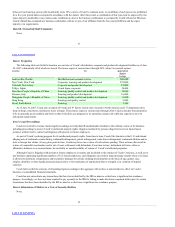Coach 2006 Annual Report Download - page 18
Download and view the complete annual report
Please find page 18 of the 2006 Coach annual report below. You can navigate through the pages in the report by either clicking on the pages listed below, or by using the keyword search tool below to find specific information within the annual report.
Fiscal 2007 34.1% 42.3% 36.2% 37.6% 38.0%
Fiscal 2006 31.3% 40.8% 32.0% 34.3% 35.1%
Gross profit increased 27.9% to $2.0 billion in fiscal 2007 compared to $1.6 billion in fiscal 2006. Gross margin remained strong at
77.4% in fiscal 2007 compared to 77.7% in fiscal 2006. Gross margin was negatively impacted by channel mix, as Coach Japan grew more
slowly than the business as a whole while our factory store channel grew faster, as well as the fluctuation in currency translation rates.
However, these negative impacts were partially offset by gains from product mix shifts, reflecting increased penetration of higher margin
collections and supply chain initiatives. Coach’s gross profit is dependent upon a variety of
22
factors, including changes in the relative sales mix among distribution channels, changes in the mix of products sold, foreign currency
exchange rates, and fluctuations in material costs. These factors, among others, may cause gross profit to fluctuate from year to year.
Selling, general and administrative (“SG&A”) expenses comprise four categories: (1) selling; (2) advertising, marketing and design; (3)
distribution and consumer service; and (4) administrative. Selling expenses include store employee compensation, store occupancy costs,
store supply costs, wholesale account administration compensation and all Coach Japan operating expenses. These expenses are affected by
the number of Coach and Coach Japan operated stores open during any fiscal period and the related proportion of retail and wholesale sales.
Advertising, marketing and design expenses include employee compensation, media space and production, advertising agency fees, new
product design costs, public relations, market research expenses and mail order costs. Distribution and consumer service expenses include
warehousing, order fulfillment, shipping and handling, customer service and bag repair costs. Administrative expenses include
compensation costs for the executive, finance, human resources, legal and information systems departments, as well as consulting and
software expenses. SG&A expenses increase as Coach and Coach Japan operate more stores, although an increase in the number of stores
generally results in the fixed portion of SG&A expenses being spread over a larger sales base.
During fiscal 2007, SG&A expenses increased 18.8% to $1.0 billion, compared to $866.9 million in fiscal 2006, driven primarily by
increased selling expenses. However, as a percentage of net sales, SG&A expenses decreased to 39.4% during fiscal 2007, compared to
42.6% during fiscal 2006, as we continue to leverage our expense base on higher sales.
The following table presents the components of SG&A expenses and the percentage of sales that each component represented for fiscal
2007 compared to fiscal 2006:
(dollars in millions)
Selling $ 718.0 $ 576.6 24.5% 27.5% 28.4%
Advertising, Marketing and
Design
119.8 100.6 19.1 4.6 4.9
Distribution and
Consumer Service
53.2 42.2 26.1 2.0 2.1
Administrative 138.6 147.5 (6.0) 5.3 7.2
Total SG&A Expenses $ 1,029.6 $ 866.9 18.8% 39.4% 42.6%
The increase in selling expenses was primarily due to an increase in operating expenses of North America stores and Coach Japan. The
increase in North America store expenses is attributable to increased variable expenses related to higher sales, new stores opened during the
fiscal year and the incremental expense associated with having a full year of expenses related to stores opened in the prior year. The increase
in Coach Japan operating expenses was primarily driven by increased variable expenses related to higher sales and new store operating
expenses. However, the impact of foreign currency exchange rates decreased reported expenses by approximately $6.1 million. The
remaining increase in selling expenses was due to increased variable expenses to support sales growth in other channels.
The increase in advertising, marketing and design costs was primarily due to increased staffing costs and design expenditures as well
as increased development costs for new product categories.
Distribution and consumer service expenses increased primarily as result of higher sales volumes. However, efficiency gains at the
distribution and consumer service facility, partially offset by an increase in our direct-to-consumer shipments as a percentage of total
shipments, led to a decrease in distribution and consumer service expenses as a percentage of net sales.
23
























